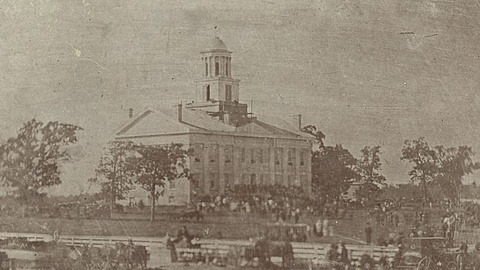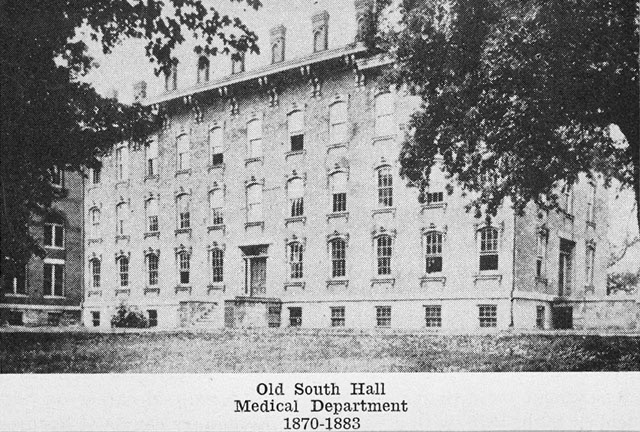Main navigation
Researched and Written by
Dr. Fred Stamler

The Constitution of the new State called for the establishment of a state university at Iowa City. The first General Assembly of the State Legislature passed an act on February 25, 1847, to implement the provisions of the Constitution. Having thus addressed the educational needs of the State, the Legislature adjourned (a familiar pattern of action for Iowa legislative bodies). The act was signed at once by Governor Ancel Briggs, and provided the guidelines for the origin and development of a state university.
The "State University of Iowa" to be established at Iowa City was to be financed by sale or rental of two townships of land granted by Congress for the exclusive support of the university and "such branches as the General Assembly shall establish." The university was to be governed by a Board of Trustees appointed and controlled by the General Assembly. The university was to be housed in the existing capitol building unless otherwise provided by law. It was assumed that governmental functions would leave the capitol facilities free for other uses much of the year, and that a new state capitol would be selected within a short time.
Several vexing problems, financial and otherwise, delayed the start of the new University. The land sales were slow in providing money; the selection of a new capitol was delayed; there was great difficulty in recruiting faculty and a President or Chancellor; and intense competition arose over formation of "branches" of the university. Although the Constitution and Legislature acts required that the university be located in Iowa City, it was argued that "branches" could and should be located elsewhere. Many were proposed and several authorized, but only the "medical branch" at Keokuk succeeded. One crucial problem was partially solved when Amos Dean of Albany, New York, accepted the position of Chancellor on a part-time basis, while still maintaining residence in Albany and continuing to hold positions in the Albany Law School and several other New York educational institutions. Under his leadership, three University "Departments" were organized. These were the Collegiate Department, or university proper; the Normal Department for teacher training; and the Preparatory Department for students with inadequate credentials for University admission. The first class entered the university in September, 1855, for a two semester course of forty weeks, with a student body of 124 (83 "gentlemen" and 41 "ladies") and a faculty of five. Only 25 qualified for the Collegiate Department, 40 enrolled in the Normal Department, and 65 took all or part of their courses in the Preparatory Department. The majority of students were from Iowa City or nearby communities, and the University soon came to be derided as the "Johnson County High School".
Until 1857 the Mechanics Academy had provided the only housing available to the University. This building, constructed in 1842 by the Mechanics Mutual Aid Association, had previously been utilized by a private "academy", and later served as Iowa City’s first public school. The building was first rented by the State, and remodeled to serve as the first home of the University of Iowa. The State later acquired ownership and the building continued to serve the University in various ways until demolished in 1898 to make way for the first University Hospital building.
Under the leadership of Chancellor Dean, the "President in absentia", the university barely managed to hold its own for the next several years, and a state of crisis became evident when a new State Constitution was adopted in 1857.

The new Constitution of 1857 designated Iowa City as the site of the State University, with no branches to be located elsewhere. Des Moines now became the Capitol, and the Old Capitol building became available as the center of University activities. The State Legislature was persuaded to provide funds for renovation and alterations, which included a fence about the Old Capital grounds to keep out hogs and other roving livestock. Funds were also granted for construction of a boarding house to encourage enrollment of students from more remote areas of the State. This building, known as South Hall, later was converted to classrooms and other uses.
The University was placed under the control of a newly created State Board of Education, which then appointed a new seven member board of trustees retaining only one of the original fifteen. Upon the recommendation of the chancellor, the Trustees temporarily closed the Collegiate and Preparatory Departments, and advocated the permanent abolition of the latter as soon as other institutions of learning became available to serve its function. All of the faculty except Professor Wells of the Normal Department were dismissed. The Trustees insisted that the chancellor reside in Iowa City, which caused Amos Dean to resign. They also voted to exclude women students from the Collegiate Department, but this unpopular rule was never enforced, and was rescinded by the Board of Education a year later, thus justifying the claim that the University has maintained its coeducational status throughout its existence.
The Board of Trustees regarded the closing of the University in 1858 as a temporary measure, and worked vigorously to enable it to reopen. The Normal Department had remained in operation, with continued success, and in 1859 the Trustees voted to reopen the Collegiate Department as of September, 1860, with a new President and faculty. Early attempts were made to eliminate the Preparatory Department, but the scarcity of adequate high schools in the State necessitated the continuance of that branch of the University until 1878. By this date high schools and academies had become generally available with educational standards in keeping with university admission requirements, and the University had established itself as a true institution of higher learning.